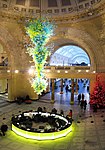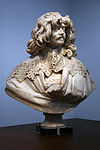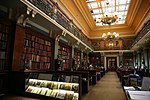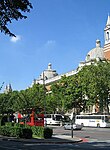Cast Courts (Victoria and Albert Museum)

The Cast Courts (originally called the Architectural Courts) of the Victoria and Albert Museum in London, England, comprise two large halls. Unusually for a museum, the Cast Courts house a collection not of originals, but copies. Here are to be found reproductions of some of the most famous sculptures in the world. Most of the copies were made in the 19th century and in many cases they have better resisted the ravages of time, 20th-century pollution and over-zealous conservation than the originals. In a few cases, such as the late 15th century Lübeck relief of Christ washing the Apostles' feet, the original has been destroyed and the cast is a unique record of a lost work.
Excerpt from the Wikipedia article Cast Courts (Victoria and Albert Museum) (License: CC BY-SA 3.0, Authors, Images).Cast Courts (Victoria and Albert Museum)
Cromwell Road, London Brompton (Royal Borough of Kensington and Chelsea)
Geographical coordinates (GPS) Address Phone number Website Nearby Places Show on map
Geographical coordinates (GPS)
| Latitude | Longitude |
|---|---|
| N 51.496666666667 ° | E -0.17194444444444 ° |
Address
Victoria and Albert Museum (V&A)
Cromwell Road
SW7 2RL London, Brompton (Royal Borough of Kensington and Chelsea)
England, United Kingdom
Open on Google Maps










